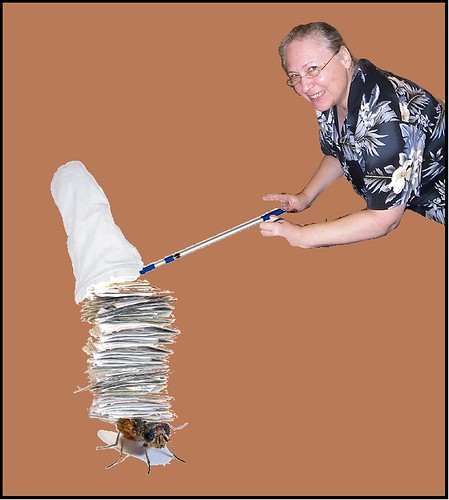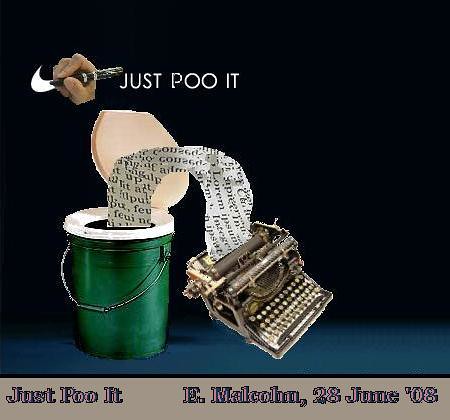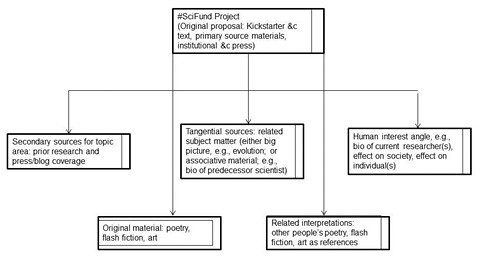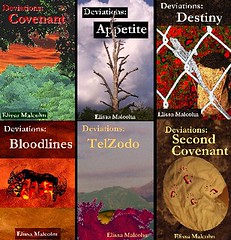It's Official: A NaNoWriMo Crazy Person Lives Here

I'm capturing raw data on the fly!
(Butterfly net image courtesy of eNasco; housefly image courtesy of
Wikipedia; paper pile courtesy of Your Action Business Coaches)
There's a reason NaNoWriMo is National Novel Writing Month. It implies that participants have done their background research and at least some plotting in advance and are ready to settle in, chained to their chairs, and -- well, do this:

(Nike slogan and background courtesy of Steven Kovar's blog; writing hand courtesy of Miguel Helft's May 30, 2007, New York Times article on pen computing; Underwood courtesy of The Classic Typewriter Page; Reliance Luggable Loo® courtesy of Campmor; toilet paper courtesy of The Lorem Ipsum Bracelet.)
Being a nonfiction rebel is a whole 'nother matter.
Being a nonfiction rebel chronicling new developments as they unfold each day is a real whole 'nother matter!
The new information that is being generated even as I type and that I have yet to mine from the Web not only keeps me on my toes; it helps drive the narrative. And it makes me look at my initial, rough (very, very rough) flowchart of the structure I intended to use and giggle -- in a rather maniacal, somewhat scary way.
Here's what I had planned out, back in September, using these components (taken from my notes):
1. The #SciFund project pool itself. That would be the section yet to be created at RocketHub (how early did I do the flowchart shown below? The text inside it says Kickstarter), in which the scientists involved present their work and solicit backing. That would be the easiest information to access (once it's available).
2. Secondary sources for each project: press coverage, prior research, general background.
3. Tangential sources: related material, not necessarily background material.
4. Human interest angle, either with respect to the scientists themselves and/or with respect to their work and the implications thereof.
5 and 6. Original creative interpretations. Those could include my own interpretations (for example, similar to the science poems I've done) as well as references to other people's interpretations, whatever those may be.

Bwaaaahahahahaha!
It occurred to me, rather quickly, that this would likely mean writing in 30 days something that would rival the Oxford English Dictionary in volume. Which in turn could have led to my mumbling, "Shoot me now."
But instead something really neat started happening.
I'm approaching NaNo completely bass-ackward, but I'm already a rebel so why not? This first week of the month I'm devoting about 70 percent toward capturing raw data on the fly (see instructional graphic above). And I'm scribbling narrative notes that are just slightly more coherent than this primate voice in my head that keeps going Ooh! Ooh! Ooh!
The data gathering is time- and labor-intensive, but well worth it in my long-run scheme of things. For one thing, I'm still working my way down the #SciFund project list and transcribing all the project videos, because they have terrific material!
Do you want cute? Get a load of the Atlantic puffins that Robin Freeman is tracking. Or the tuco-tuco now living in the shadow of a volcanic eruption, one of several "Species in Peril" being studied by Stanford University's Hadly Lab. That video (with additional cute species!) also does a terrific takeoff on 60 Minutes -- or, in this case, 180 Seconds -- with PhD students/news anchors Melissa Kemp and Jeremy Hsu.
Want sheer adventure? Tune into "Dr. Zen" Faulkes's quest for the Amazon crayfish and peek into a history of scientific exploration that would make Indiana Jones proud. (Indiana Jones fans: Watch this.) I won't tell you where this video gave me my laugh-out-loud moment; go see it for yourself.
"I will do my best to appear to be menaced by snakes," Faulkes writes on his project page. Can't wait for that? Go over to Chip Cochran's venomous reptile hangout at Loma Linda University, where he studies deadly venom in his quest for anti-venom and therapeutic drug potential. He's on camera holding southwestern speckled rattlesnakes on two hooked poles, one with each arm. He wants to explore the potential differences in venom between the snake from Arizona and the one from California. He's so at ease with these lethal reptiles that as he lifts each pole in turn I think of a dessert waiter offering diners their choice of cheesecake or Boston cream pie.
I'll have more about what catches my eye as I gather information (tweets! blogs!). One thing that excites me is that although these are separate #SciFund projects, they are related on several levels. Camaraderie is one: these researchers have connected and bonded across the world (see?), and the #SciFund Challenge strikes me as one collective expedition into new territory for all involved. The #SciFund site on RocketHub is their exploratory vessel in which they are all co-travellers.
Another level -- one that I am just beginning to see and want to explore in my writing for NaNo -- has to do with certain thematic connections among the different projects. Like energy derived from plants. Go to Jeffrey Bodwin's quest to free cellulose from all parts of a plant and you're looking at the potential for vastly improving the generation of biofuels. Then go to Walter Weare's work on artificial photosynthesis, which seeks to mimic what those plants do, with the ultimate goal of creating biofuel without the bio part. Two chemists are approaching the same basic problem, using different strategies. I love that.
Or take DNA. When I think of DNA I see this:

But when Kristina Killgrove sees it, she's teasing it out of the skeletons of long-forgotten Roman slaves from two millennia ago, to learn about how they lived and where they came from.
And when the Center for Conservation Biology's researchers see it, they're teasing it out of feces to identify which birds and bats prey on insect pests like the coffee berry borer, in their quest to understand how wildlife and farmers can benefit each other in the present day.
But wait! There's more!
But you'll have to wait for it, until I blog again.
Because I have to chase after more raw data and scribble more notes.












0 Comments:
Post a Comment
<< Home